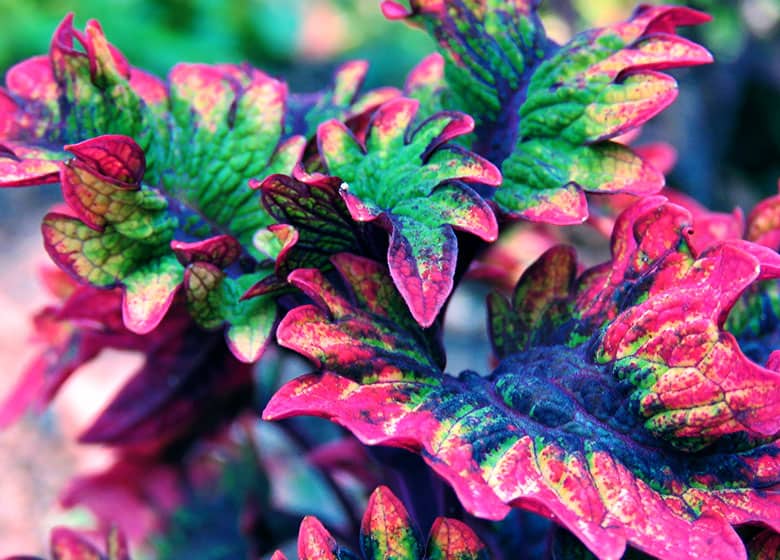A Kaleidoscope Of Color And Versatility In The Garden – mygardenchannel

Introduction:
In the world of ornamental plants, few can rival the vibrant and versatile nature of Coleus. With its kaleidoscope of colors and striking foliage patterns, this beloved plant, scientifically known as Plectranthus scutellarioides, has become a staple in gardens and landscapes around the globe. In this essay, we will explore the captivating characteristics, cultivation techniques, and the undeniable allure of Coleus as a vibrant and transformative element in the garden.
Overview of Coleus:
Coleus is a tropical perennial plant native to Southeast Asia and is a member of the Lamiaceae family, which includes aromatic herbs like mint and basil. What sets Coleus apart is its foliage, which showcases an extraordinary range of colors, patterns, and textures. From vibrant hues of red, pink, purple, and orange to contrasting veins and intricate patterns, Coleus foliage adds an element of drama and visual interest to any garden.
Characteristics and Growth Habit:
Coleus displays several unique characteristics that make it an extraordinary addition to the garden:
- Foliage: The foliage of Coleus is its most distinguishing feature. Leaves come in a wide array of shapes, ranging from serrated and lobed to deeply dissected. What truly sets Coleus apart is its mesmerizing palette of colors. Leaves can exhibit solid shades, bi-colors, or multi-color combinations, making each plant a work of living art.
- Growth Habit: Coleus has a bushy and compact growth habit, typically reaching a height of 1 to 3 feet (30 to 90 centimeters). However, there are trailing varieties that gracefully spill over containers or cascade down walls, adding a cascading charm to hanging baskets or vertical gardens.

Cultivation and Care:
To successfully cultivate Coleus in your garden, consider the following care guidelines:
- Sunlight and Temperature: Coleus thrives in bright, indirect light. While it can tolerate some morning or evening sun, it generally prefers partial shade or filtered light, especially during the hot summer months. Coleus appreciates moderate temperatures between 70-85°F (21-29°C).
- Soil and Watering: Provide Coleus with well-draining soil rich in organic matter. It benefits from regular watering to keep the soil evenly moist, but avoid waterlogged conditions. Take care not to let the soil dry out completely, as it can cause stress and leaf drop.
- Fertilization: Coleus is not particularly heavy feeders, but a balanced, water-soluble fertilizer applied every four to six weeks during the growing season can promote healthy foliage growth. Follow the package instructions for appropriate dilution and frequency.
- Pruning and Pinching: Regular pruning and pinching of Coleus plants help maintain compact and bushy growth. Pinching involves removing the terminal growing tips, which encourages lateral branching and results in fuller plants. Prune any leggy or straggly stems to maintain an attractive shape.
- Propagation: Coleus can be easily propagated from stem cuttings. Take cuttings of 3-4 inch (8-10 cm) stem sections, remove the lower leaves, and place them in a moist potting mix. Keep the cuttings in a warm and humid environment until they root, which usually takes a few weeks.
- Overwintering: Coleus is generally grown as an annual in temperate regions. However, in mild climates, it can be overwintered by bringing potted plants indoors or by taking cuttings to grow as new plants the following season.
Benefits of Coleus:
Beyond its captivating beauty, Coleus offers several benefits to gardeners and the surrounding environment:
- Focal Point and Contrast: With its vibrant foliage, Coleus serves as a focal point in the garden, effortlessly drawing attention and providing a dramatic contrast against green foliage or flowering plants. It adds depth and interest to beds, borders, and containers.
- Versatility in Design: Coleus is highly versatile in garden design. It can be used as a border plant, ground cover, accent plant, or in mixed containers. Its trailing varieties are excellent choices for hanging baskets, window boxes, or spilling over retaining walls.
- Low Maintenance: Coleus is relatively low maintenance, making it suitable for gardeners of all levels of experience. Its resilience, adaptability, and ability to thrive in various light conditions contribute to its ease of care.
- Pollinator Attraction: While the main focus of Coleus is its foliage, some varieties produce inconspicuous flowers that attract beneficial pollinators, such as bees and butterflies, enhancing biodiversity and supporting ecosystem health.
Conclusion:
Coleus (Plectranthus scutellarioides) stands as a testament to the astounding diversity and beauty of foliage plants. With its kaleidoscope of colors, captivating leaf patterns, and versatility in design, Coleus has earned its place as a garden favorite. Whether used as a focal point, contrast element, or ground cover, Coleus offers endless possibilities for creating stunning visual displays. Embrace the vibrant and transformative nature of Coleus and let it bring a kaleidoscope of color to your garden, elevating it to new heights of beauty and enchantment.